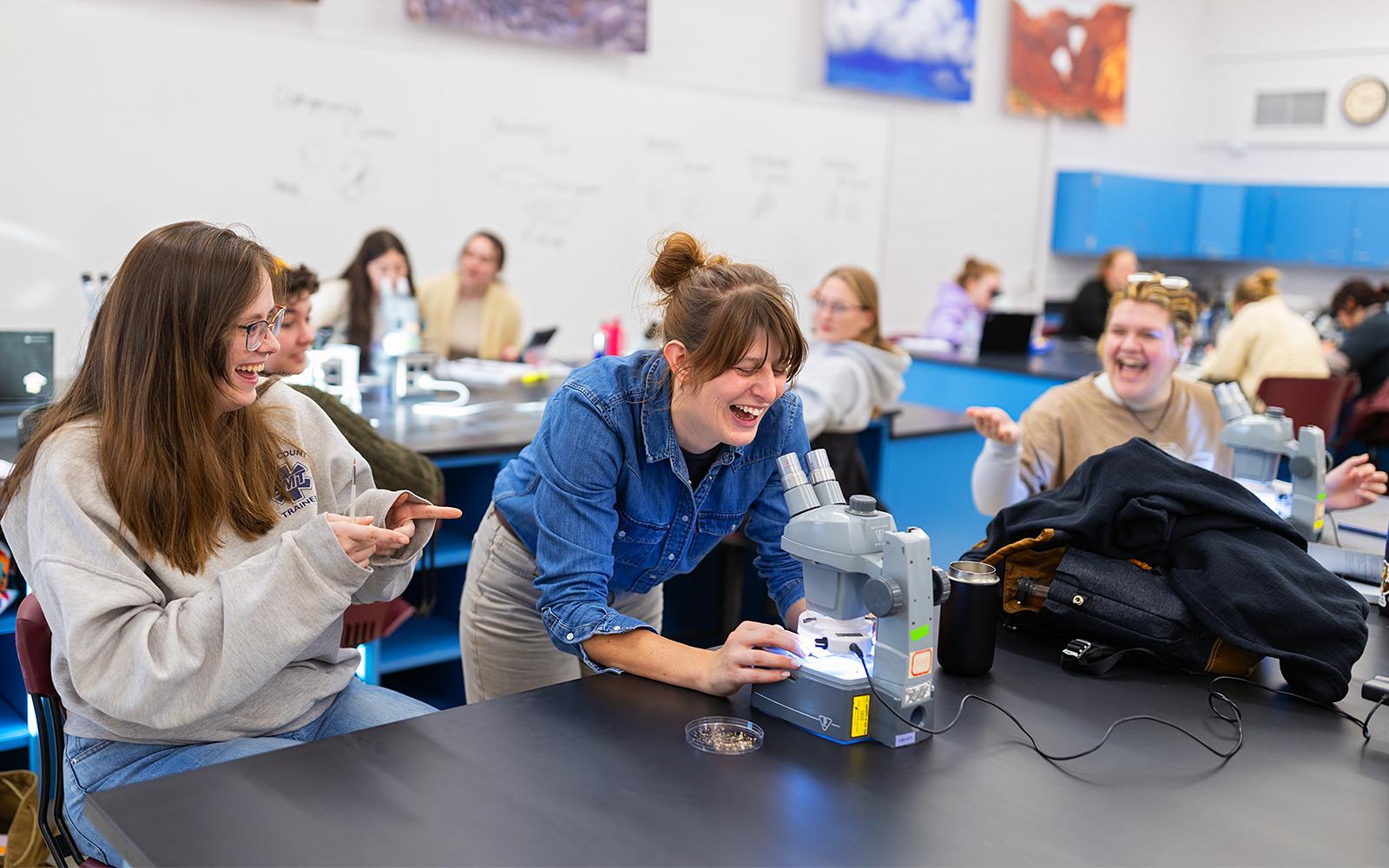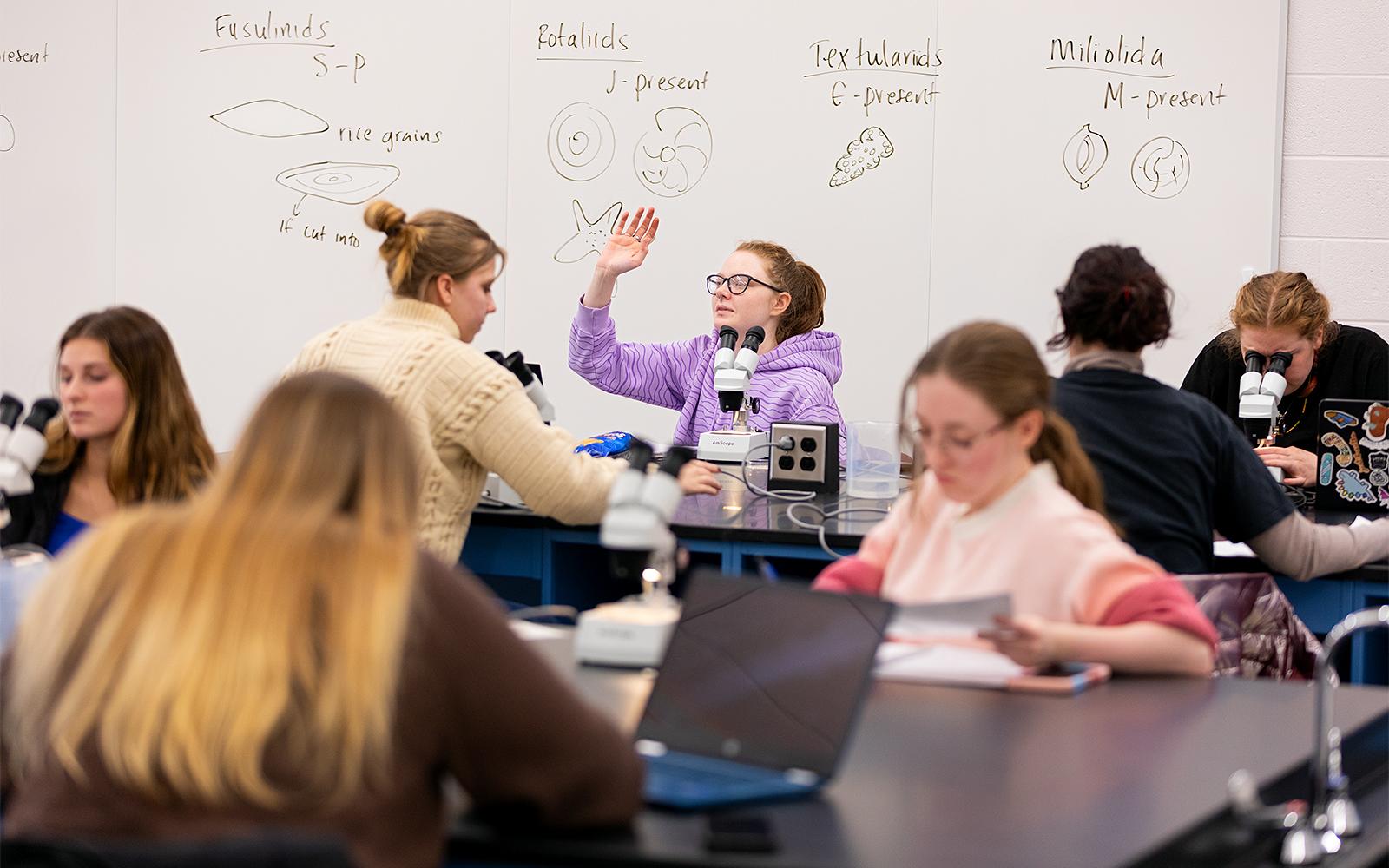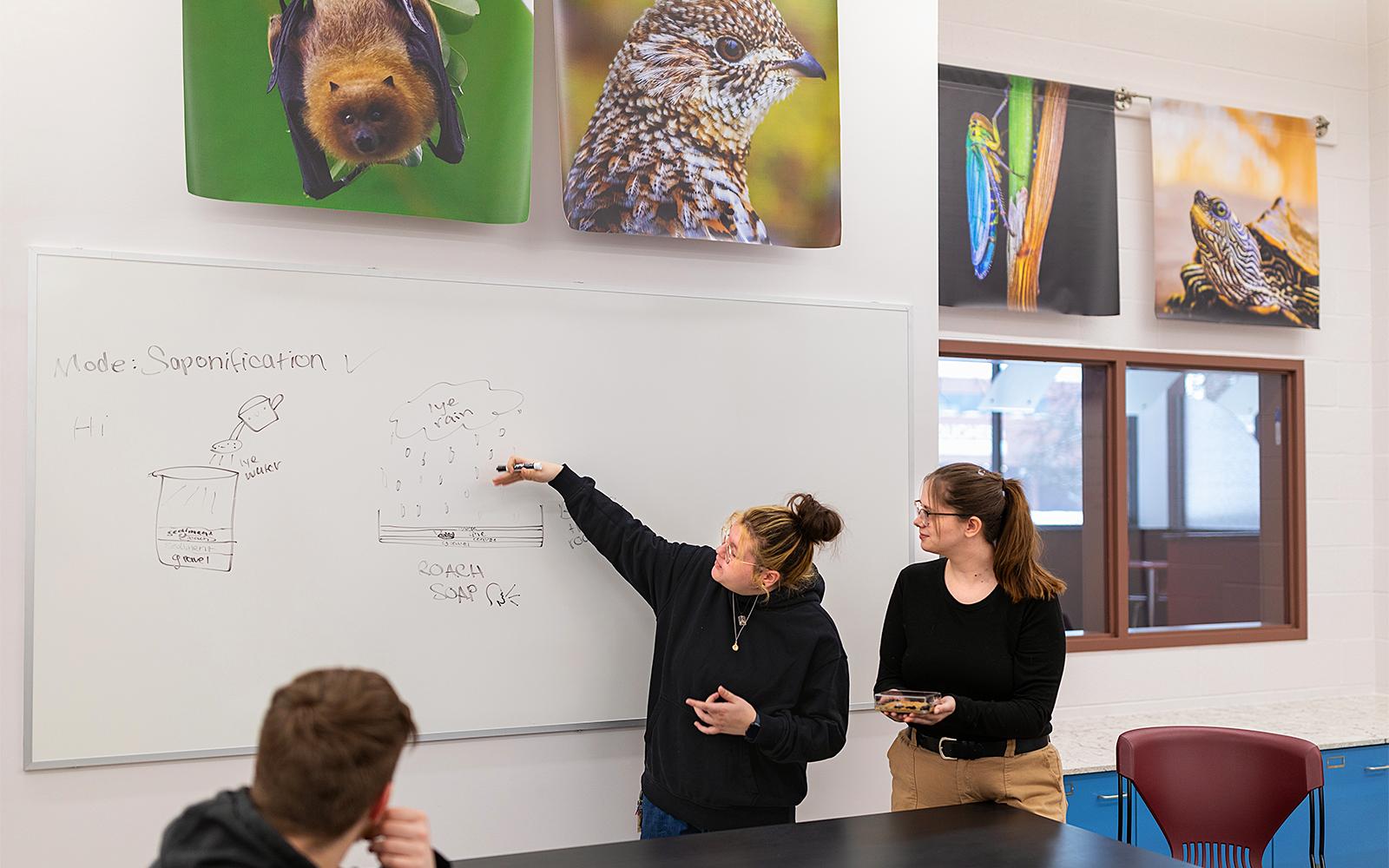As Dr. Page Quinton moves around the new Environmental Science lab—helping students in her Principles of Paleontology class learn how to fossilize insects—she reflects on all improvements in Timerman Hall made over the past few years to advance applied learning initiatives at the College.
“This space was designed to be a wet lab where students could work with water samples, soils, and biological specimens. It represents the interface between the sciences of geology, biology, and chemistry… which is what Environmental Science is. Not only is the space practical, but it is also beautiful and calming. The windows to the outside allow us to look out but also allow passing students to look in and see all the cool stuff the students get to do."
Geology Professor

Her students recently completed a fossilization lab where they created their own thick syrupy solution to seal and preserve their specimens, dead cockroaches in this instance. Using honey, salt, sand, mud, and charcoal, they placed the bugs in an oxygen-free vile—preserving them in the same way that mosquitos have been frozen in time within a glob of amber for millions of years.
“After spending two weeks learning about how fossils form, the students were tasked with applying what they learned in a controlled experiment. This mimicked what taphonomists do. They perform experiments where they try to see how to fossilize organisms in different ways,” Quinton said. “The lab for the course is very specimen-based, students get time to work with SUNY Potsdam’s excellent and extensive fossil collection, which has been built by previous members of our department and alumni donations.”
The fossilization exercise is just one of the numerous hands-on activities in Quinton’s paleontology course, a required class for students pursuing a degree in geology, but also taken by education, biology, and environmental science majors. Students learn how fossils are formed, examine evolutionary patterns based on the fossil record, learn about mass extinction events, and receive an overview of major animal phyla ranging from sponges to dinosaurs. Students are also tasked with sketching and labeling fossils as they build their own identification notebook, a personalized resource guide they will be able to use for years to come.
"In the lab, we looked at microfossils that could provide insight into how organisms react to environmental changes, which can help us address environmental challenges today. I didn't appreciate fossils as much as they deserved until Dr. Quinton showed me how crucial they are in understanding Earth's history. They open a window to what the ancient environments might have been like and the life forms that once inhabited them. Fossils are truly remarkable and essential to understanding our planet!"
Geology Major

“The course focuses on the history of life on Earth, how to identify the major fossil forming groups, and how to use fossils to reconstruct past environments,” Quinton said. “Students also learn about functional morphology, or how to infer the function from the structure of an organism’s body, for example, how did the T-rex walk and run.”
The new Environmental Science lab, recently completed and being used for the first time by Quinton’s students, boasts many new features to supplement hands-on learning, including a wet lab and whiteboards on every wall.

Dr. Page Quinton, left, speaks with Emma Robbins '25, a geology major, during their Principles of Paleontology lab.
“It’s a space that’s designed for students to take on leadership roles and drive their experiments and their discussions. It’s not a normal classroom, it’s one where they can come in, they get to design their experiments, and they present their findings."
Geology Professor
Hanging above the whiteboards on each wall are large-scale photographs featuring insects, animals, rocks, and plants that correlate to the specialized fields and research of SUNY Potsdam professors. To name a few, high-resolution photos of a bat and fox represent the work of Environmental Studies Professor Dr. Kate Cleary, photos of a turtle and a grouse connect with Biology Professor Dr. Glenn Johnson’s research, an image of Purple Loosestrife represents the ongoing work of Environmental Studies Professor Dr. Jessica Pearson, and images of geological formations represent the work of Geology Professor Dr. Mike Rygel and Dr. Page Quinton.
“The prints highlight the various things that our faculty do, the interdisciplinarity of environmental science, and the connections we have on this campus with each other,” Quinton said.

Moving forward, professors in the Departments of Earth and Environmental Science, Biology, and Environmental Studies will be using the new space for classes ranging from Ecology and Soil Science to Sedimentary Geology and Environmental Science.
Stepping outside the new lab, and a short walk down the Timerman hallway brings Quinton’s students to a unique replica of a juvenile Diplodocus (named Dipper after a campus-wide vote). Purchased with funds from an Arconic grant, the skeleton is another opportunity for active learning.
“When the skeleton was delivered last semester, two of the students from my paleontology course in 2023 helped put it together and mount it. This year, the students will use the skeleton for an exercise on how paleontologists identify bones and determine where they go when mounting a skeleton,” Quinton said. “We will also learn about curation and best practices for making replicas and casts of bones. This semester will be the first that we formally use the dinosaur in a class.”
Back down the hall, next to the Environmental Science lab, another new space is just being finalized. Housing two unique stream tables—which simulate how water and erosion impact landscapes—will be used for Dr. Adam Pearson’s Geomorphology classes. Students already trained to use the tables will lead a workshop for middle and high school at the end of February as part of a special STEM Day event. Quinton has been the catalyst for these community outreach events over the past few years, with hundreds of middle and high school students visiting the College every semester.
"The design of this lab was a true collaboration between the teaching faculty, Roy Smith (SUNY Potsdam Facilities), and Doug Schaefer (Mach Architecture)," said Dr. Rygel. "We focused on two things: making sure the teaching space was functional and that current students, prospective students, and the community could all see the kinds of hands-on learning that we do at SUNY Potsdam."
Article and photos by Jason Hunter
